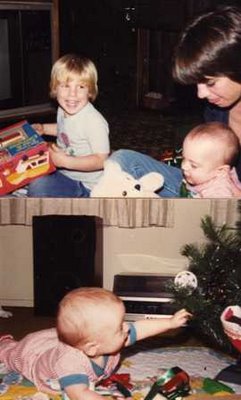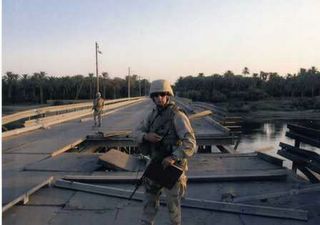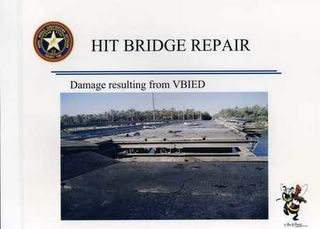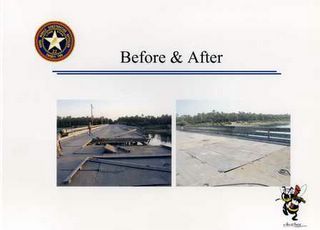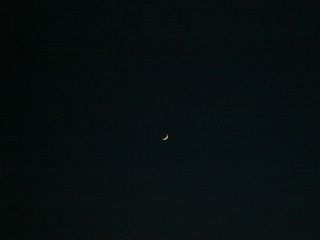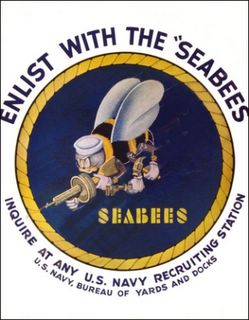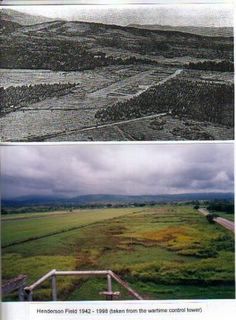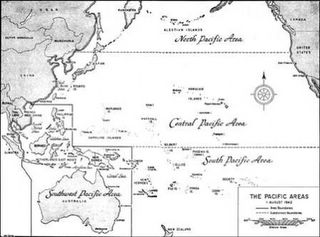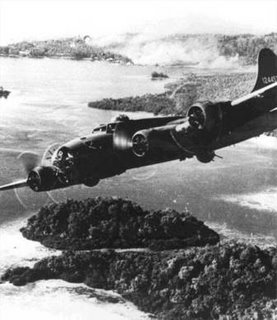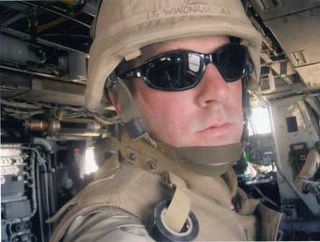Saturday, December 23, 2006
Some People Really Believe In What They Don't Believe In?
ke
S a wHolE bUnch oF
sEnsE, huh?- -
. .
/\
Gunz Up
wants to know:
Did you manage to get your Christmas cards sent to the prisoner detainees who despise you and everything you stand for? No matter what it is?
If you know what you stand for.
Or do you just hate?
Most of our readers know that I rarely drift off into politics. That's best left to Mom. But I've tried to let this article I read on FOXNews.com go all day. It's just the most ridiculous thing I've read in a while. I just couldn't let it go anymore.
Here's to insanity.
+++
California Man Sets Himself, American Flag, Christmas Tree on Fire to Protest Religious Names
Saturday , December 23, 2006
BAKERSFIELD, Calif. — A man used flammable liquid to light himself on fire, apparently to protest a San Joaquin Valley school district's decision to change the names of winter and spring breaks to Christmas and Easter vacation.
The man, who was not immediately identified, on Friday also set fire to a Christmas tree, an American flag and a revolutionary flag replica, said Fire Captain Garth Milam.
Seeing the flames, Sheriff's Deputy Lance Ferguson grabbed a fire extinguisher and ran to the man.
Flames were devouring a Christmas tree next to the Liberty Bell, where public events and demonstrations are common.
Beside the tree the man stood with an American flag draped around his shoulders and a red gas can over his head.
Seeing the deputy, the man poured the liquid over his head. He quickly burst into flames when the fumes from the gas met the flames from the tree.
The deputy ordered the man to drop to the ground as he and a parole agent sprayed him with fire extinguishers.
"The man stood there like this," the deputy said with his arms across his chest and his head bent down, "Saying no, no, no."
The man suffered first degree burns on his shoulders and arms, Milam said.
Kern County Sheriff's Deputy John Leyendecker said the man had a sign that read: "(expletive) the religious establishment and KHSD."
On Thursday, the Kern High School Board of Trustees voted to use the names Christmas and Easter instead of winter and spring breaks.
All I can say is: Christmas Christmas Easter Easter Christmas Christmas Easter Jesus Jesus Jesus Jesus. Christmas Easter.
I'm sorry, Father.
Forgive him also.
And open his eyes.
but sometimes I just want to strike the match for people like this.
And shut my mouth.
But help me to
Remember,
It was the Veteran, not the reporter,
who has given us freedom of the press.
It was the Veteran, not the poet,
who has given us freedom of speech.
It was the Veteran, not the lawyer,
who has given us the right to fair trial.
It was the Veteran, not the campus organizer,
who has given us freedom to demonstrate.
It is the Veteran, who salutes the flag,
who served under the flag,
and whose coffin is draped by the flag,
who allows the protester to burn the flag.
Written by: Father Denis Edward O'Brien, USMC
and my hat is off to the schools that realize it's always been Christmas and Easter break for as long as there's been a break.
Silent Night

Click here for your Christmas card that Dorothy shared. Thank you Dorothy, and Merry Christmas to all the Thomases!
Virgie Bell's View
I haven't posted in a couple of days and felt last night that it would be impossible to do so again. It seems everything is so ugly and depressing as far as the news is on T.V. and in the newspapers, and it just seems the wrong season to repeat it. I am so sick of the pathetic celebrities, the corruption of government officials and the absolute shamefulness of the U.N.
Last night I lay awake trying to understand a Koran being used to swear an elected official into power. To be honest, everything is just too mind-boggling for me to really voice an opinion on. And I am not going to give up my life to have someone jump in with different opinions. I don't care what Jimmy Carter’s father did or did not do nor do I care to research anything concerning him. I lived the life of a wife and mother and my opinions were formed from my view of history as I lived it. As I have never been anything other than what I am, a citizen in good standing with my country. I will leave to others to act as a springboard into other pools of knowledge. In 70 years plus I have never run on to a person that I wasn’t able to have a reasonable conversation in whatever subject and have never tried to pass myself off otherwise. So for today, I want to report on the passing of a Marine that I knew but a short time, yet came to admire greatly in the time I knew him.
L.W. was a man that pulled his own load with grace and dignity. First of all, I love having Thomas as a last name. My grandmother on my mother’s side was a Thomas and Lord knows I near worshiped that woman. But back to the story of my brother-in-law L.W. He married Virginia Bell Thomas (Dolly) in 1957. I didn't know about the name at the time I married Jerry and thought he was lying about it until he placed a call to Dolly to confirm it. Jerry is the baby of this large family and they each have a protective and indulgent attitude toward my husband. In my phone conversation with Dolly she remarked that she hoped we stayed married long enough for her to meet me. Well ,needless to say we did. It was a record for him and the usual thing for me.
I still remember Jerry telling me about his brothers and sisters. When he referred to this particular one of the band of brothers, his words were, “I can’t wait for you to meet them, Babe. I can't wait for you to see the house they built and their ranch ... and that L.W., well, he is just the salt of the earth.”
Seems that all the rest of the family had been beset with their own supply of misfortune and tragedy, but somehow this family had been spared ... in other words, a real Father Knows Best on TV in reality.
I met L.W. and Dolly at a family reunion, but it was a couple of years before we went to this piece of heaven on earth, a piece that a Marine and his devoted wife had carved out of this Texas town. L.W. designed and oversaw the building of this beautiful home. The back door was never locked whether they were there or not. The doors to the bedrooms where the family slept were locked and there was a loaded rifle on the side of the bed, next to the master of the home. This, his family, was all that he treasured and he would die defending that part of his treasure if he had to.
There was a small lake on this ranch and Jerry and L.W. caught several catfish, some over 20 lbs. L.W. always laughed and joked a lot with Jerry.
I said Jerry is the baby and it shows among all of them. He has a couple of cousins that I assume thought he was a hell raiser at times, but the cousins are more Jerry 's age. No one adored Jerry more than Dolly and L.W. I asked them both about their life and found out they fell in love at first sight and married within 2 weeks. They had raised four children in whom they had enormous pride, and that each of them had finished college; the youngest daughter was finishing a degree in law at Texas Tech, one son ran his own feed store in Brownwood, Texas, another son was an ordained preacher pastoring a church in Ohio, and another daughter was a wife and mother who stayed close to the family nest.
L.W. took his family deep sea fishing every summer. By the time I met them they had their own big ocean worthy boat and travel home. They had also visited just about everywhere they deemed worthy as family trips, like Carlsbad Caverns and The Smithsonian. I asked Dolly one time what it felt like to have done everything right. She was amused at my question, but when she saw I was serious,she admitted that yes, she had had a good life and was proud of what she and L.W. had achieved with their life together.
L.W. was diagnosed with cancer before Thanksgiving in 2004 and was at the point of entering aggressive treatment. Dolly was beside herself with worry. During all of this, she learned that she too, had one of the most invasive forms of cancer there is. Like her husband's, the cancer was advanced.
Dolly lost her fight, despite the radiation and other treatment she received. L.W. faced only one Thanksgiving before he left to join her before another Christmas advent. They both asked for privacy during the difficult and ravaging time they would face, though they let it be known they welcomed cards and letters. I admired their courage and dignity.
After Dolly passed away, Jerry came back from the funeral and said, "You should see where she was buried Babe. Under a tree in an old cemetery that joined their ranch property. Just where she had told L.W. she wanted to be buried ...you should see it Babe. It is all just so perfect...that L.W., even in severe illness , was still the salt of the earth.”
I had tried never to let two or three weeks go by that I didn't send them a little card saying Jerry and I thought of them and they were in our prayers. When Dolly passed on, we decided that L.W. would still receive a card in the mail. L.W. got to hear all about our house remodeling, full descriptions of paint and floor coverings, things like that. We just tried to sound forever upbeat until this Thanksgiving. At that time, we felt our card would be intrusive in a life where his boys were taking care of him. He was bedfast and needed help to get into a wheelchair.
Due to numerous health problems of my own, I missed the funeral services of these two fine people, but I wanted to share with Gunz up the passing of this significant and wonderful man, as well as his wonderful wife, Jerry’s sister.
To L.W. Richmond, his wonderful wife, Dolly, and the children you raised together, Semper Fi.
Love,
Virgie
SUPPORT OUR TROOPS
Light of the World ...Moment of Inspiration

click here for today's message
Safe traveling and the blessings of living in a free world are wished for all today.
May Joy be yours.
The World's Song
Bless us, O Lord, we beseech Thee and show us the way in which thou wouldst have us walk.
WALK with Me in the way of Peace. Shed Peace, not discord, wherever you go. But it must be My Peace.
Never a Peace that is a truce with the power of evil. Never harmony if that means your life-music being adapted to the mood and music of the world.
My disciples so often make the mistake of thinking all must be harmonious. No! Not when it means singing the song of the world.
I, the Prince of Peace, said that I came "not to bring Peace but a sword."
Russell, A. J., ed. God Calling. Barnes & Noble, 2002
Important Christmas Card Addresses for Injured Troops
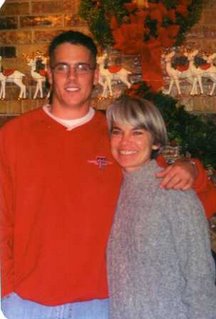
To Any Soldier or Airman
Ward 57, Walter Reed Army Medical Center, 6900 Georgia Avenue NW, Washington, DC 20307-5001.
To Any Sailor, Marine, or Airman,
Ward SE, National Naval Medical Center, 8901 Wisconsin Avenue, Bethesda, MD 20889.
The Medical Centers have asked that you do not send flowers, balloons, or gifts, but highly encourage cards or letters.
This photo was taken of me and Aaron on Dec. 23, 2003. I always smiled this big when I was around him.
To Be ...on "War Stories" March 12, 2006...
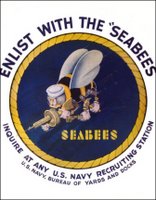 ...okay, so we're a little late for the broadcast, but you can still catch a great history lesson here!
...okay, so we're a little late for the broadcast, but you can still catch a great history lesson here!Seabees: America's Unsung Heroes
Q & A With "War Stories" Producer
FOX FAN: Who are the Seabees and how did they get their start?
AYSE WIETING: The "Seabees" are the U.S. Navy's construction battalions. Each present-day battalion has approximately 650 highly-skilled members — plumbers, electricians, heavy equipment operators, etc. — who are all trained to fight back if attacked. Their nickname comes from the initials of their military occupational specialty: "C" for construction and "B" for battalion. CBs eventually became "Seabees" due to their sea-faring nature and also partly due to their magnificent logo, created by civilian Frank Iafrate in 1942. The logo depicts a very determined bee sporting a white sailor's hat, a hammer, a wrench and a Tommy gun for when he fights. (Sea!funny, huh?) photo above.
U.S. Navy Seabees consider Rear Admiral Ben Moreell to be their founding father, or "King Bee." The Seabees didn't exist prior to World War II, but by December 1941, there were some 70,000 civilian contractors working for the Navy building advanced bases, mostly throughout the Pacific on tiny specks of coral like Midway, Wake and Guam. As war clouds gathered over Asia and Europe, Moreell had the foresight to recognize that having civilians in the middle of a war zone would be very dangerous and highly impractical, and so he rallied for the creation of construction units of skilled builders trained to fight. The Seabees were born on March 5, 1942. Moreell personally furnished them with their motto — "We Build, We Fight" — from the Latin phrase, “Construimus, Batuimus.”
For full story click here . This is very interesting and isn't too long to take a couple of minutes to read, so please check it out.
"The Navy's Fighting Seabees" aired on "War Stories" Sunday, March 12, 2006. Who all saw it?
To Be ...some of the B's Missions
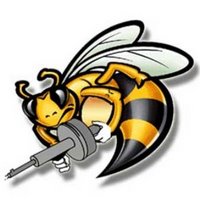
Naval Mobile Construction Battalions (NMCBs) provide responsive military construction support to Navy, Marine Corps and other forces in military operations, construct base facilities and conduct defensive operations. In addition to standard wood, steel, masonry and concrete construction, NMCBs also perform specialized construction such as water well drilling and battle damage repair. They are able to work and defend themselves at construction sites outside of their base camp and convoy through unsecured areas. In times of emergency or disaster, NMCBs conduct disaster control and recovery operations. There are Eight active duty and Twelve reserve NMCBs.
Copied from Source
Want a little action, Big Guy?

Grab a "little" popcorn and coke ...then check out the Navy's new video game!
NTE:(Naval Training Exercise) Strike & Retrieve presents a mental challenge that requires both sound reasoning and quick-thinking action on your part. At the Navy we know the missions of the future will be determined not by who is the strongest but by who is the smartest.
You can download "Strike and Retrieve" and get started right away, Karen. (Karen is highly competitive even though she's not a big guy!)
To Be ... Buzzing About LONE STAR 22

1. Seabees share the stage with VP Dick Cheney
k
2. Military.com: a Seabee from NMCB 22 leaves this post:
Thu 15 June 2006 17:29
Oohrah NMCB-40, and NMCB-25 and the 9th. I am in NMCB-22. NMCB-25 relieved us just recently. I'm sorry to hear of their losses. But, these guys are outstanding Bees in my book. I am a brother EO. These Seabees are carrying out difficult tasks in the finest tradition of the Bees. The tasks we have been given in Iraq, Kuwait and Afghanistan will help ensure the people of those countries have a fighting chance to protect themselves and the sovereignty of their nations. I was proud to have gone out there in Al Anbar Province to build for Iraqis. Give these Seabees all the support you can. They deserve it.
Bravo Zulu Bees.
Come home safe and soon.
EO2 Mark R Mayfield, NMCB-22 Det 05 San Antonio, Texas
kk
3. The #1 Google hit for LT. Richard Windham...dududhuh...drum roll please! Gunz Up presents (the images spell Gunz Up in Webdings)
Ready for the Queen Buzz? k
Okay... here GOES.
Ladies and gents:
the number 1 Google Hit for LT. Richard Windham is:
Gunz Up: LT. Richard Windham, USN
Richard Windham, USN. LT. Richard Windham, USN. This is Karen's brother, Richard. Gunz Up will be doing a special on the Seabees in general and Rich's unit ...ramosmiller.blogspot.com/2006/12/lt-richard-windham-usn.html - 29k - Dec 21, 2006 -
kkk
and if one might google "images of LT. Richard Windham," this comes up number 2:
Gunz Up
Look, you can see images across the street in the lower left hand corner. ... LT. Richard Windham, USN. This is Karen's brother, Richard. ...ramosmiller.blogspot.com/ - 287k - Cached - Similar pages
which is 2 ahead of Navy Reserve Force's number 4...
kkkk
Navy Reserve Force
File Format: PDF/Adobe Acrobat - news and images by e-mail to navresfor_tnr@navy.mil or by mail to: The Navy Reservist, ... said Lt. Richard Windham, officer-. in-charge of COP South. [editor's note: don't be snooping around COP South, we've got to finish building that bridge in Hit, remember? Besides, we're going to COP South for Christmas.]...navyreserve.navy.mil
kkkkk
so, Rich,
Who loves ya, baby?
It's been fun. 'Til next time, keep buzzing kkkkkk ...hhhh
Friday, December 22, 2006
Doc Duty is in Afghanistan
 In the photo from left to right: Sgt. Major Skiles (Aaron's !st Sgt. in OIF 2), Sgt. Rett, who carried Aaron, short-stuff me, and Doc Duty.
In the photo from left to right: Sgt. Major Skiles (Aaron's !st Sgt. in OIF 2), Sgt. Rett, who carried Aaron, short-stuff me, and Doc Duty.This message came on Aaron's message board today. Doc was with Aaron when he passed. He'd worked on him more than once. Please keep Doc Duty in your prayers.
"Dear Deon,
I apoloize for just recently receiving the message from 01 OCT, but i have been deployed to Afghanistan since Aug. Do you still need assisstance with that freind of yours? I finally (like 6 months later) received the bracelet i ordered with aaron's info on it and wear it proudly every day. Your son is still an inspriation to me and my junior troops every day.
Take care"
Doc Duty of Camp Phoenix, Afghanistan
Do You Hear What I Hear?

My family can tell you that the wind chimes on my front porch remind me that Aaron is near. I’ve had these wind chimes since Aaron was a teenager.
Steve was here for the night and this morning we talked about my wind chimes. Both of us had noticed how they hadn’t been twinkling much since last night. Actually, I hadn’t heard them as much as usual for a few days, which saddened me. But this morning while we were talking about it, suddenly, they started chiming over and over again. There wasn’t much of a breeze, whereas last night there was.
Steve’s on his way home now, but I just wanted him to know my chimes have been singing all afternoon.
Some will think I’m crazy for relating the chimes to Aaron. I’m not, and I’ll bet that nearly anyone who’s lost someone has a special way in which they feel the presence of their “missing” loved one.
I’m sure I’ve relayed to you before that the birds make me think of God, of life, of God’s promises, and of His mercy’s rebirth with each rising of the sun. When the sun comes up, we can know that God’s covenant has held. God is not a covenant breaker. It doesn’t even matter if we believe that or not. It is what it is, and if God has revealed His Word to you within your heart, within your hurting soul, if He has told you something in His Word, it will hold. You can bank on it.
The Bible is His Last Will and Testament. His Word nourishes our spirit just as bread nourishes our body. If you are hurting, then ask Him to show you something. He will.
He’s God. Who created and controls the breezes. The sunrise, the sunset. The time of the tide.
Our coming in. Our going out.
If He said He will perform it, He will.
I need to remember this right now and I need to nourish my own spirit.
There are a few I’ve really been praying for today. And I’ve asked God to help me write something encouraging, whether my tears flowed or not. After a while of restlessness and still trying to come up with something for the readers I so love, I finally said, “LORD! There is nothing I can say or do. What am I thinking? Look at me.”
But He reminded me that you are His and He will care for you.
Don’t think it strange if some peace or joy touches you, tugs at your shoulder, invites you into its unfathomable banquet and nourishes you, touches your forehead and bids you to stay a while. Oh my friends, it is like the breezes and the gentle music of my chimes, it comes and goes and though we can’t tell where it comes from, its presence is truly within us if we will but take the time to search it out and though it be fleeting, in our limited grasp of the ways of the Spirit at least, it is real, and He will never forsake you or leave you comfortless.
The Word of the LORD.
And from me, I do truly love you all and will pray most generously for you over the next few days. Please pray for me too.
Click here to listen to "Do You Hear What I Hear?"
Ghosts of Christmases Past
Ghosts of Christmases Past
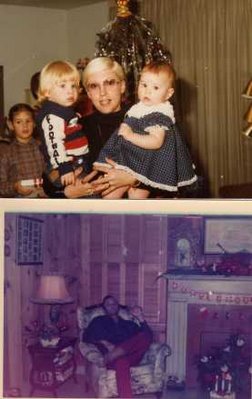 2. Uncle Mickey, who passed while I was in Panama. I'm not sure what year this is. Uncle Mickey is my mom's brother who was just 18 months older than her. He is also Tonya's dad.
2. Uncle Mickey, who passed while I was in Panama. I'm not sure what year this is. Uncle Mickey is my mom's brother who was just 18 months older than her. He is also Tonya's dad.Yes, I say "is" not "was" because he is still brother and dad. And truly, he is very photogenic. So handsome!
Ghosts of Christmases Past
Ghosts of Christmases Past
Ghosts of Christmases Past
Chuck is with Aaron in Heaven. Aaron's paternal grandfather passed in September 2003. Aaron was devasted but wore his Dress Blues and delivered a very loud and profound eulogy befitting his grandfather. Later, some of Chuck's retired working buddies got to meet and talk with Aaron, at which point they asked Aaron to apply for a job with the sheriff's department there when he got out of the Marines. (I'm not sure which county in Cali, probably Orange, maybe LA ...) but anyway, Aaron asked his dad later for Chuck's sheriff's ring. Doug told Aaron he would have to wait, that he needed time for that decision.
At Aaron's funeral, Doug had the director open up Aaron's casket one more time before they lowered it. Doug gave the funeral director Chuck's ring, and it was placed on Aaron's finger right before his precious body was committed to the earth.
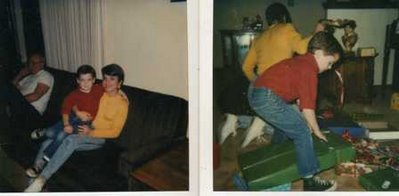
2. Mom and Aaron 1987
Ghosts of Christmases Past
Practise Protection
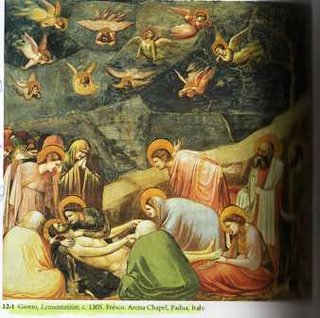 Keep in mind these writings come from two women who lived in England many years ago, so sometimes the spellings are different, as with the 's' in 'practise' in today's message.
Keep in mind these writings come from two women who lived in England many years ago, so sometimes the spellings are different, as with the 's' in 'practise' in today's message.
December 22
FEAR no evil because I have conquered evil. It has power to hurt only those who do not place themselves under My Protection. This is not a question of feeling, it is an assured fact.
All you have to do is to say with assurance that whatever it is cannot harm you, as I have conquered it. Children, in not only the big, but the little things of life, be sure of My conquering Power. Know that all is well. Be sure of it. Practise this. Learn it until it is unfailing and instinctive with you.
But practise it in the quite small things, and then you will find you will do it easily, naturally, lovingly, trustingly, in the big things of life.
Russell, A.J., God Calling. Barnes & Noble, 2002.
To Be ... Seabees That Rebuildt Hit Bridge
LT. Richard Windham, the brother of Karen, my sister-in-law, was Alpha company commander of Naval Mobile Construction Battalion-22 while they were deployed to Iraq from October 2005 to March 2006.
I've been excited to get to present this series to our readers. When Gunz Up was first erected, one of our primary goals was to relay "the good news." Well, no doubt, when the Seabees are around, you're going to find some good news.
Besides that, Richard is very special to me, and before the stories of NMCB 22 are finished being told here, I'll prepare a special narrative as to the day Richard was there to lend a little bit of a repair to the damage of my own "bridge."
I think you'll enjoy this series. I know I will, but then, I was once an engineer myself! (Thank God I didn't have to build anything though! :>
Enjoy!
De'on
Marines and Seabees rebuild Hit BridgeMarine Corps News ^ Oct 13, 2005 1st Lt. Rob Dolan
Posted on 10/13/2005 5:51:16 PM PDT by SandRat
HIT, Iraq (Oct. 13, 2005) -- Navy Seabees and Marines from Regimental Combat Team-2 and Soldiers from Task Force 2-114, Mississippi National Guard, repaired a section of bridge here yesterday that was heavily damaged by an insurgent car bomb September 4.
The bridge spans the Euphrates River connecting Hit to the suburb of At Turbah on the eastside of the river.
Navy Seabees conducted site surveys and assessments on the bridge and decided the best way to get the two cities connected again was by prefabricating a patch for the bridge to repair the damaged section.
“They rehearsed the move in and repair several times prior to movement to the site,” according to Navy Lt. Cmdr. Darcy Wolfe, Assistant Operations Officer, 30 Naval Construction Regiment.
The citizens of Hit received a huge morale boost when the Seabees and Marines of Regimental Combat Team – 2 appeared on the scene, geared up and ready to repair the vital infrastructure.
The 1st Battalion, 2d Brigade, 7th Iraqi Army Division (or 1-2-7 IA) provided security by cordoning the bridge on both sides of the river and erecting barriers and defensive schemes that will protect the bridge against future incidents.
“Actual construction took three days – two days to perform the second site survey, confirm all measurements, pre-fab the solution and rehearse. The final day was transporting the solution to the site and performing the repairs to the bridge, which took approximately four hours,” said Wolfe.
The mood in Hit was described by the Sailors as ‘good and the citizens appeared extremely pleased’ now that the inconvenience they had suffered for the past month has been rectified.
“We had one sniper round come in after we were off the bridge, but it hit the bridge and no one was injured. I guess the bad guys slept in too late and missed the opportunity,” said Navy Lt. Richard Windham, Alpha company commander, Naval Mobile Construction Battalion-22.*
The bridge will be open to pedestrian traffic only, until after the October 15 referendum at which point it will be opened to controlled vehicular traffic.
Late morning on Sept. 4, Marines witnessed a white Suburban stop in the middle of the bridge, moments later an explosion echoed through the city. When the fire and smoke cleared a large section of the aging bridge was missing and the citizens of At Turbah were effectively cut off from the city, eliminating their shortest route to the local hospital.
Marines and Iraqi Soldiers began providing permanent presence in Hit in late July when the joint force rolled through the city during Operation Saif (Sword). Since then the Soldiers and Marines have been conducting routine patrols and targeted raids against suspected terrorists.
Al Qaeda in Iraq terrorists have been using an intense murder and intimidation campaign focused at discouraging Iraqi citizens from voting in the referendum and cooperating with Coalition Forces.
*[editor's note] I can just picture Richard saying the bad guys must have slept in late. How cute... :)
Here is another article that is similar.
Thursday, December 21, 2006
Merry Christmas Greg
 Thomas Kinckade Train for the tree with a 6-8 wk. delivery time=seventy something dollars and some odd cents. Plus shipping.
Thomas Kinckade Train for the tree with a 6-8 wk. delivery time=seventy something dollars and some odd cents. Plus shipping.Gundt Teddy Bear that will be late=forty-nine something dollars and some odd cents, or double that for two to three day delivery which I absolutely am not that crazy.
One other gift that will be late=one hundred twenty-nine plus shipping.
Box of Christmas cards (for next year now)=five ninety-nine plus tax.
Lisa being at Wal Mart instead of me=I'm hideous.
Only 4 days left to get deeply in debt.
Yep, I'm doing pretty good this year!
MERRY CHRISTMAS HONEY
Lubbock Marine Parents

Another neat site I just discovered is Lubbock Marine Parents. They have a great blog and I've just read where they have sent out 251 care packages!
They have some Marine jokes posted too, which are funny! Check it out if you have time. I'll put their link up as well!
Merry Christmas Flag Gazer and SGT. Hennessy!
 ristmas!
ristmas! God bless you and yours!
Please go to Flag Gazer's site and check out Sgt. Hennessy's red kettle for the Salvation Army. She's in Iraq right now and can't do what she's done for years ...ring the bell for the needy! So she's doing it online this year and has already raised over $3,000. Many of our troops have added to the little red bucket.
Flag Gazer's site is great with many ways to help the troops. When I have time, I'll see if there's some links I can borrow from her to benefit our troops from this end.
Anyway, check it out. It'll lighten your load! Click here for the link.
The First Day of Winter

Hey everybody,
Happy first day of winter. It's nice and warm here, but I know it's not that way for everyone. Steve will be here about midnight due to the cold weather damage and ice they've had in the panhandle. Weather in southeastern New Mexico and our borders with Texas can change in a heartbeat, but nothing like the panhandle. It's one of the reasons I don't try to go to Aaron's grave during this time of year. Every year on December 11, I have a 3 x 5 grave blanket put on his grave. It's made of evergreen and pine cones. Very natural. A little red. They've been beautiful and I will do that every year. Aaron's dad keeps flowers on it the rest of the year.
When I go to Aaron's grave, I like to stay a long while. To go in the winter would be hard. I think it would make me pretty sad to just be there a few cold minutes and then leave.
I was there on the 11th of December the first year, as that was to be his wedding day. It was in the 70's that day. I'd never seen anything like it. For Amarillo, that is very unusual.
I want to apologize to everyone for not sending out Christmas cards this year. I guess that's pretty terrible of me, but most of the time, I'm here, or working on getting here. I think I could easily become an invalid here.
I remember my grandmother, MaMa, getting to a point in her life where she was never far from her couch. Her coffee table held her calendar, one with a page for each day of the year. Every day MaMa recorded the weather and news of the day, if there was something newsy to add. But no matter what, the weather was recorded. After all, they'd always farmed for a living and their lives depended on the weather. And truly, all of ours do. But MaMa had her meals there, her flat toothpicks for later. They had a big huge ashtray, red, and it was heavier than their little coffee table. It was almost as if the red ashtray held the table down. There were never any ashes in it, whereas my ashstay stays full. I've always smoked a lot, but never more than I do now.
If any of you wonder how I am, I am fine. True, everything is a little tender right now, but I still love it. I will always love this time of year, and Christmas was Aaron's favorite! My parents always gave us three kids the best Christmases, so I guess we've practiced the same thing for our own little branches that have happened along! Even if we were broke at Christmas, we managed to do something special for it. I don't understand how people don't love it. If it wasn't regarded as a time to recognize the birth of our savior, it is a time of giving, and I can't imagine that people don't like giving. It feels so good.
For those of you who read my posts, I imagine there's many out there who are sad or broken hearted right now. I'm sorry. I really am, and it's strange when I don't have something to say, but in this case, in the case of talking to someone who is sad this time of year, it is so understandable, and there's really not much that can be said. Sometimes I think more people hurt than are happy. And truly, it's okay too. It may be harder on you to try and be happy when it's just not there for you. Don't force it and try to rest or find someone to be around who just lets you be quiet or sad. Greg is that way with me when I need it.
I do want you all to know that Gunz Up has been very good for me. While I've done very little this year toward gifts, cards and that sort of thing, I have enjoyed the Christmasy things to put on the blog. Christmas can never be for me what it was. This is the first year I've not tried to force that "for everyone else around me" and it's been good. Maybe next year I'll want to do those things again, but I just haven't wanted to this year. Greg put everything up and I love looking at it. But the "busyness" of it all has totally evaded me this year.
All of you, whether you comment or just read, I appreciate you. And I love you, and I hope we have many more Christmases together. You can't put your heart and soul into writing for someone you may never meet, and not consider them, not wonder about them. You want them to be okay.
God bless and send you warmth for this season He's created with beauty and purpose.
Wednesday, December 20, 2006
Gunz Up
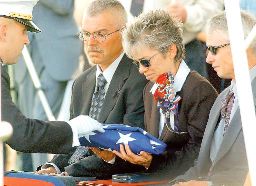
salutes 61 Troops stationed in Iraq ....
1 stationed in Afghanistan
and Their Families
for the sacrifice you've given this
December 2006.
We pray for you and we are very humbled by your devotion and service.
With heaviness, we share in your sorrow, and a little bit like you, we're numbed by such a loss.
The photo in this post is of Captain Sorrells, USMC handing me the flag that draped the casket of my son who was buried May 3, 2004. My husband, Greg, sits to my right and Aaron's dad, Doug, sits to my left.
We feel your pain.
In May 1918 President Wilson approved the suggestion of the Women's Committee of National Defenses. It recommended that American women should wear a black band on the upper left arm, adorned with a gold star. Each star representing a family member who had given his or her life for their country. This was suggested in lieu of conventional mourning attire.
The "star" tradition began in WW I when white Service Flags were displayed from homes, business, schools and churches to indicate, by the use of a blue star, each active service member in the U.S. Military. A gold star stitched over a blue star showed the nation those who had given their lives for their country and the devotion and pride of those left behind. This tradition continued through WW II. for more, follow link below.
Gold Star Mothers; a history
Music
Iraq's Fallen buried at Arlington
Afghanistan's Fallen buried at Arlington
Day is done,
gone the sun,
from the lakes
from the hills
from the sky,
all is well,
safely, rest,
God is near.
Fading light,
Dims the sight,
And a star gems the sky
Gleaming bright,
From afar,
Drawing, near,
Falls the night.
Thanks and praise,
For our days,
Neath the sun
Neath the stars
Neath the sky,
As we go,
This, we, know,
God is near.
To Be: Early Construction in the Pacific
Naval Construction Battalions were organized around the allowance of 33 officers and 1,081 enlisted personnel. They were organized in five companies including a headquarters company and four construction companies. The organizational allowance was designed to provide a self-sustaining unit with individual and organizational equipment, vehicles, supplies and material to perform construction work. The original planning resulted in battalions being assigned as a functional component part of advanced bases known as CUBS, ACORNS and LIONS which were the code names for standard advanced naval bases. Naval Construction Battalions were "completely equipped and self-sustaining able to construct airfields, roads, bridges and buildings at an advanced base and to install, operate and maintain its public utilities."
The first naval construction unit to deploy from the United States was designated the First Construction Detachment. The unit left Quonset Point (Newport), Rhode Island, on 17 January 1942. It stopped at Norfolk, Virginia, and Charleston, South Carolina, and on 27 January left for Bora Bora in the Societies Islands with the mission of constructing a fueling station and other facilities. The 296 men of the unit arrived on 17 February 1942. This unit took on the name of Bobcat Detachment as Bobcat was the code name for Bora Bora. On 5 March, Construction Battalion personnel were officially named Seabees by the Navy Department and the fighting, building bee insignia and shoulder patch was approved.
The initial NCB to be organized was the 1st NCB which was commissioned at Camp Allen, Virginia, near Norfolk, in March 1942. Deployment resulted in companies being sent to Tonga Tabu and Efate, New Herbides, in April 1942. The 2nd NCB arrived in the southwest Pacific in April and May of 1942. The 3rd, 4th and 5th NCBs arrived in the Pacific in June 1942. The 6th NCB, which was destined to be the first naval construction battalion to come under enemy fire, was activated at Camp Allen, Virginia, on 24 June 1942, and went from Gulfport, Mississippi, to Moffett Field, California, and on to San Francisco. It left for the south Pacific on 21 July on the USS President Polk and the USS Wharton with five other ships escorted by the light cruiser USS Helena (CL-50). The 6th NCB reached Esprito Santo on 11 August via Pago Pago, Samoa.
continued on next post.
Copied from Seabeecook.com
To Be: First Seabees on Guadalcanal
On 20 August Lieutenant Commander Joseph P. Blundon, CEC, USNR, who was Officer-in-Charge of the 6th NCB, arrived in a PBY which landed off Lunga Point. He immediately called on General Vandegrift and his planning was directed at work on Henderson Field. Lieutenant Commander Blundon requested two companies from his NCB at Esprito Santo be sent forward with a few extra men trained for special details such as water purification and machinery repair. Early in the week of August 24th, directions were received from Commander, South Pacific Amphibious Force (Task Force 62, Rear Admiral R. K. Turner, USN) to transfer four hundred personnel to Cactus, two hundred each on the transport USS Fuller (AP-14) and the cargo ship USS Betelgeuse (AK-28). Companies A and D were designated and boarded the USS Betelgeuse on Saturday.
This first contingent landed on 1 September 1942 and consisted on 357 men and five officers under Lieutenant (Junior Grade) Thomas L. Stamp, CEC, USNR. Lieutenant Commander Blundon had departed by aircraft to Esprito Santo on 27 August and returned on 29 August with Commander James P. Compton, USN, who was Commanding Officer of CUB-1. Lack of transportation shipping, enemy action and the need for other priority unit and supply shipments caused the 6th NCB to arrive in elements. The second element of 156 men from the 6th NCB departed Esprito Santo on 29 August and arrived on Guadalcanal on 26 September. The third, fourth and fifth elements arrived on 2, 9 and 12 October resulting in 1,002 men, including 17 officers, on Guadalcanal-Tulagi by mid-October. Formed in July 1942 at Camp Allen and had moved to Port Hueneme, California. It departed on 9 September for Noumea, New Caledonia, and arrived on 29 September. Rear Admiral Turner, Commander, Amphibious Forces South Pacific, had proposed a plan of action on 3 July 1942 to Admiral Nimitz (in response to a plan request from Admiral Ernest King) to include the "occupation of Ndeni Island." This island is located about 300 miles west of Tulagi and had been used by the Japanese for a temporary air base during war games in 1940. After Turner's proposal the Ndeni operation gained approval from Nimitz and those above up to the Joint Chiefs of Staff. Read Admiral Turner issued his plan for the operation, code name HUDDLE, on 20 August. However, after the Guadalcanal operation needed additional resources and, after General Vandegrift and others at the operational level in the theater spoke against the use of valuable resources at Ndeni, the operation was canceled by Admiral Halsey on 20 October 1942. After that decision Turner urged that the troops last earmarked for that operation (and staged at Noumea) be switched to Aola on Guadalcanal where he envisioned the construction of an airfield. The 14th NCB was organized as part of ACORN-1, a land plane advanced base. The landing occurred on 4 November under the direction and control of Turner's Task Force 65. Transport Divisions Eight and Twelve disembarked the following units from USS Neville (AP-16), USS Fomalhaut (AK-22) and USS Heywood (AP-12) in an amphibious landing at Aola (about 50 miles to the east of Lunga and the developing Naval Operating Base there):
Lieutenant Colonel E. F. Carlson's Second Marine Raider Battalion, C and E companies as the advance landing party and the main body force
1st Battalion, 147th Infantry, US Army, Colonel W. B. Tuttle, Commanding Officer
ACORN-1 personnel - about 100 Navy personnel
14th NCB personnel - about 500 Seabees and 2000 tons of supplies and equipment
Artillery batteries for the Army's Americal Division
5th Marine Defense Battalion detachments
Marine Corps AA batteries and coastal defense guns (155-millimeter howitzers)
The main body force consisted of approximately 1700 personnel. The second section of the 14th NCB arrived in two elements on 29 November and 23 December. In addition, other NCBs arrived on Guadalcanal and Tulagi during the battle period of 7 August 1942 to 9 February 1943. The 18th NCB was formed at Camp Allen on 11 August and transferred to Davisville, R. I. On 6 September, C Company was transferred to the C. B. Replacement Group, Fleet Marine Force, San Diego, California. The remainder of the battalion was transferred to the FMF Base Depot, Norfolk, and embarked on 11 September 1942 as part of the Second Marine Division arriving at Noumea, New Caledonia, on 11 November. B Company landed on Guadalcanal on 6 December with A, D and Headquarters companies arriving on 12 December. More 18th NCB elements arrived on December 19 and 25.
to be continued.
Copied from Seabeecook.com
Rear Admiral Ben Moreell

Founder of the Seabees
Made You Look.
Navy Seabees on Guadalcanal
By Capt. Larry G. DeVries, CEC, USNR, Ret.
The events that led to the participation of the Seabees in the battle for Guadalcanal in World War II started with the actions taken by Rear Admiral Ben Moreell, Chief of Civil Engineers, and the staff of the Bureau of Yards and Docks (BUDOCKS) in the early weeks of the war. Captain John N. Laycock, Civil Engineer Corps, was in charge of the planning for Seabee units and expanded on the early work of Commander Walter H. Allen at the Great Lakes Naval Base who had pioneered the concept of construction units composed of naval personnel. When the war began, Rear Admiral Moreell expanded and acted on the planning that had taken place and began to organize several units of Civil Engineer Corps officers and skilled petty officers. On 5 January 1942, Rear Admiral Moreell's superiors directed him to begin recruiting the men that were to form the Navy's new construction battalions. Seabee enlisted men were recruited with skills needed in the battalions and came primarily from the construction industry. Civil Engineer Corps officers, many with prior military and construction experience, were commissioned to serve in the units.
Copied from this Source
2/1 Journal Entries from Guadalcanal!
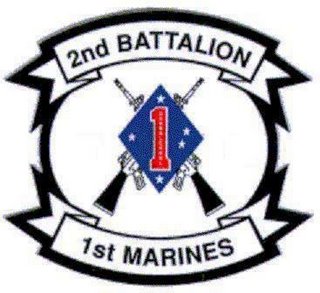 All credit to this post goes to the children of the Marine who recorded this powerful journal. Be sure to click on the links to the site below for more of this journal written by a Marine who was in the same battalion as Aaron.
All credit to this post goes to the children of the Marine who recorded this powerful journal. Be sure to click on the links to the site below for more of this journal written by a Marine who was in the same battalion as Aaron.And when he gets to Heaven
To St. Peter he will tell:
"One more Marine reporting, Sir --
I've served my time in Hell."
Sgt. James A. Donahue
United States Marine Corps.
First Marine Division (H-2-1)
To Hell and Back: A Guadalcanal Journal
The jungle is thick as hell. The Fifth Regiment landed first and marched to the airport. We went straight through and then cut over to block the escape of the Japs. It took three days to go six miles. Japs took off, left surplus first day, which was done away with.
The second day was murder. All along the way were discarded packs, rifles, mess gear and everything imaginable. The second night it rained like hell and the bugs were terrific. The Second Battalion (First Regiment) had reached the Lunga River... [emphasis mine.]
The third day we came back. The Japs had beat us in their retreat. We took up beach defense positions. We have been bombed every day by airplanes, and a submarine shells us every now and then. Our foxholes are four-foot deep. We go out on night patrols and it’s plenty rugged. We lay in the foxholes for 13 to 14 hours at a clip and keep firing at the Japs in the jungle. As yet, there is no air support. The mosquitoes are very bad at night. The ants and flies bother us continually. The planes strafed the beach today. A big naval battle ensued the second day we were here, which resulted in our ship, the Elliott, being sunk. All of our belongings were lost.
[editor's note: This exciting journal was first began while he was a PFC with 2/1 in Guadalcanal. His son continues with his own intro. This is great!]
So begins my father’s firsthand account of his grueling experience on the island of Guadalcanal. He wrote his Guadalcanal Journal in 1942 when he was a 21-year old Marine, but more than a half-century would go by before my brother and sisters and I got to read it. For years the brown leather Journal lay buried in a bureau drawer. The miniscule words had faded and were hard to decipher. Then, last July, not long after my father’s death, my mother found a typed transcript of the diary among his papers. My dad had never talked much about Guadalcanal when he was alive. Now we know why.
Blood Is Thicker Than Water:( Continued) Operation Watchtower Comes Into Being
FIRST OFFENSIVE: The Marine Campaign for Guadalcanal
by Henry I. Shaw, Jr.
On 23 January 1942, Japanese forces seized Rabaul and fortified it extensively. The site provided excellent harbor and numerous positions for airfields. The devastating enemy carrier and plane losses of the Battle of Midway (3-6 June 1942) had caused Imperial General Headquarters to cancel orders for the invasion of Midway, New Caledonia, Fiji, and Samoa, but plans to construct a major seaplane base at Tulagi went forward. The location offered on of the best anchorages in the South Pacific and it was strategically located: 560 miles from the New Hebrides, 800 miles from New Caledonia, and 1,000 miles from Fiji.
The outposts at Tulagi and Guadalcanal were the forward evidences of a sizeable Japanese force in the region, beginning with the Seventeenth Army, headquartered at Rabaul. The enemy's Eighth Fleet, Eleventh Air Fleet, and 1st, 7th, 8th, and 14th Naval Base Forces also were on New Britain. Beginning on 5 August 1942, Japanese signal intelligence units began to pick up transmissions between Noumea on New Caledonia and Melbourne, Australia. Enemy analysts concluded that Vice Admiral Richard L. Ghormley, commanding the South Pacific Area (ComSoPac), was signaling a British or Australian force in preparation for an offensive in the Solomons or at New Guinea. The warnings were passed to Japanese headquarters at Rabaul and Truk, but were ignored.
The invasion force was indeed on its way to its targets, Guadalcanal, Tulagi, and the tiny islets of Gavutu and Tanambogo close by Tulagi's shore. The landing force was composed of Marines; the covering force and transport force were U.S. Navy with a reinforcement of Australian warships. There was not much mystery to the selection of the 1st Marine Division to make the landings. Five U.S. Army divisions were located in the South and Southwest Pacific: three in Australia, the 37th Infantry in Fiji, and the Americal Division on New Caledonia. None was amphibiously trained and all were considered vital parts of defensive garrisons. The 1st Marine Division, minus one of its infantry regiments, had begun arriving in New Zealand in mid-June when the division headquarters and the 5th Marines reached Wellington. At that time, the rest of the reinforced division's major units were getting ready to embark. The 1st Marines were at San Francisco, the 1st Raider Battalion was on New Caledonia, and the 3d Defense Battalion was at Pearl Harbor. The 2d Marines of the 2d Marine Division, a unit which would replace the 1st Division's 7th Marines stationed in British Samoa, was loading out from San Diego. All three infantry regiments of the landing force had battalions of artillery attached, from the 11th Marines, in the case of the 5th and 1st; the 2d Marines drew its reinforcing 75mm howitzers from the 2d Division's 10th Marines.
continued in post below.
Blood Is Thicker Than Water: Finale to Operation Watchtower Comes Into Being
An amphibious operation is a vastly complicated affair, particularly when the forces involved are assembled on short notice from all over the Pacific. The pressure that Vandegrift felt was not unique to the landing force commander. The U.S. Navy's ships were the key to success and they were scare and invaluable. Although the Battles of Coral Sea and Midway had badly damaged the Japanese fleet's offensive capabilities and crippled its carrier forces, enemy naval aircraft could fight as well ashore as afloat and enemy warships were still numerous and lethal. American losses at Pearl Harbor, Coral Sea, and Midway were considerable, and Navy admirals were well aware that the ships they commanded were in short supply. The day was coming when America's shipyards and factories would fill the seas with warships of all types, but that day had not arrived in 1942. Calculated risk was the name of the game where the Navy was concerned, and if the risk seemed too great, the Watchtower landing force might be a casualty. As it happened, the Navy never ceased to risk its ships in the waters of the Solomons, but the naval lifeline to the troops ashore stretched mighty thin at times.
This completes the intro to the Marines' first offensive attack on Guadalcanal. The next copied post from Marine Corps History will begin with the battle itself.
Back to Top
Commemorative Series produced by the Marine Corps History and Museums Division
WANTED
 Someone we'd like to know more about is my cousin, Shea. He is Uncle Bennie and Aunt Linda's son. His brother, Shawn is a year older.
Someone we'd like to know more about is my cousin, Shea. He is Uncle Bennie and Aunt Linda's son. His brother, Shawn is a year older.Anyone with information leading to the arrest of an article about this important person in our family and nation's life may send it to: deonmiller7@hotmail.com
A reward is not available at this time, however, we would like to honor those who serve our nation during these dangerous times.
USS New Yorker from WTC Steel
By RICHARD PYLE
NEW YORK Apr 3, 2006 (AP)— With a year to go before it even touches the water, the Navy's amphibious assault ship USS New York has already made history twice. It was built with 24 tons of scrap steel from the World Trade Center, and it survived Hurricane Katrina.
That combination of disasters gives the ship a unique standing among the 500 or so Avondale, La., shipyard workers building it, said Tony Quaglino, a crane superintendent who postponed retirement to have a hand in the New York's construction.
Click here for entire article.
Blood Is Thicker Than Water: Background and Info on the Pacific in WWII
The broad drives from the Central and South Pacific during 1943 and 1944 were both aimed at the Philippines. The war in the North Pacific was over on August 15, 1942 after first retaking the Aleutian Islands the June prior. When the Allies hit Kiska in August and found the Japanese forces on the island had been evacuated prior to the attack, the battles in the North Pacific were finished.
In the South Pacific the general objective was to bypass and neutralize the Japanese airbase at Rabaul. This was accomplished by taking the Solomons and northern coast of New Guinea. The Allies surrounded Rabaul by first taking the Admiralty Islands.
It was U.S. Admiral Ernest King, Commander in Chief of the United States Fleet who conceived the plan of attack against the southern Solomons. He proposed the offensive to deny the use of the southern Solomon islands by the Japanese as bases to threaten the supply routes between the U.S. and Australia, and to use them as starting points for a campaign with the goal of isolating the major Japanese base at Rabaul while also supporting the Allied New Guinea campaign, with the eventual goal of opening the way for the U.S. to retake the Philippines. U.S. Admiral Chester Nimitz Allied commander in chief for Pacific forces, created the South Pacific theater, with U.S. Vice Admiral Robert L. Ghormley in command, to direct the Allied offensive in the Solomons.
Henson, Griffith. A More Perfect Union Volume II: Since 1877. (139, 140). 1991
Further, on Commemorative Series produced by the Marine Corps History and Museums Division, I found and copied this:
Tactical command of the invasion force approaching Guadalcanal in early August was vested in Vice Admiral Frank J. Fletcher as Expeditionary Force Commander (Task Force 61). His force consisted of the amphibious shipping carrying the 1st Marine Division, under Rear Admiral Richmond K. Turner, and the Air Support Force led by Rear Admiral Leigh Noyes. Admiral Ghormley contributed land-based air forces commanded by Rear Admiral John S. McCain. Fletcher's support force consisted of three fleet carriers, the Saratoga (CV-3), Enterprise (CV-6), and Wasp (CV-7); the battleship North Carolina (BB-55), 6 cruisers, 16 destroyers, and 3 oilers. Admiral Turner's covering force included five cruisers and nine destroyers.
Flying Fortress Makes Discovery
Blood Is Thicker Than Water: Operation Watchtower Comes Into Being
I'll just paste in small chunks at a time. Here's the first, and full credit goes to Henry I. Shaw, Jr. whose publication is provided in the link above.
FIRST OFFENSIVE: The Marine Campaign for Guadalcanal
by Henry I. Shaw, Jr.In the early summer of 1942, intelligence reports of the construction of a Japanese airfield near Lunga Point on Guadalcanal in the Solomon Islands triggered a demand for offensive action in the South Pacific. The leading offensive advocate in Washington was Admiral Ernest J. King, Chief of Naval Operations (CNO). In the Pacific, his view was shared by Admiral Chester A. Nimitz, Commander in Chief, Pacific Fleet (CinCPac), who had already proposed sending the 1st Marine Raider Battalion to Tulagi, an island 20 miles north of Guadalcanal across Sealark Channel, to destroy a Japanese seaplane base there. Although the Battle of the Coral Sea had forestalled a Japanese amphibious assault on Port Moresby, the Allied base of supply in eastern New Guinea, completion of the Guadalcanal airfield might signal the beginning of a renewed enemy advance to the south and an increased threat to the lifeline of American aid to New Zealand and Australia. On 23 July 1942. the Joint Chiefs of Staff (JCS) in Washington agreed that the line of communications in the South Pacific had to be secured. The Japanese advance had to be stopped. Thus, Operation Watchtower, the seizure of Guadalcanal and Tulagi, came into being.
The islands of the Solomons lie nestled in the backwaters of the South Pacific. Spanish fortune-hunters discovered them in the mid-sixteenth century, but no European power foresaw any value in the islands until Germany sought to expand its budding colonial empire more than two centuries later. In 1884, Germany proclaimed a protectorate over northern New Guinea, the Bismarck Archipelago, and the northern Solomons. Great Britain countered by establishing a protectorate over the southern Solomons and by annexing the remainder of New Guinea. In 1905, the British crown passed administrative control over all its territories in the region to Australia, and the Territory of Papua, with its capital at Port Moresby, came into being. Germany's holdings in the region fell under the administrative control of the League of Nations following World War I, with the seat of the colonial government located at Rabaul on New Britain. The Solomons lay 10 degrees below the Equator—hot, humid, and buffeted by torrential rains. The celebrated adventure novelist, Jack London, supposedly muttered: "If I were king, the worst punishment I could inflict on my enemies would be to banish them to the Solomons."
to be continued.
Tuesday, December 19, 2006
Never Forget!

Freedom Rising Steel columns are erected in the footprints of the World Trade Center as construction on Freedom Tower begins.
I got this off FOX's site. It's an AP photo. Nice, huh?
What Our Australian Cousins Think Of Us ... And Other Things That Don't Matter
The Englishman was helpful, calling people he thought could help me. He insisted I accompany him to the offices of Turner Construction so I could talk to those contractors about getting me into Baghdad. The Australian, though, was a different story.
He had nothing positive to say, and, instead, repeatedly told me how insane I was to even consider going to Iraq.
"Do you speak Arabic?" he asked.
"No," I said.
"Then you're doomed," he prophesied.
"Do you have thousands and thousands of dollars to pay for security while you're in Iraq? To pay for an interpreter? To pay for a driver?"
"No," I said to each question.
The Australian threw his hands up in the air to convey his belief that I was worse than a fool.
The Englishman, I could tell, was embarrassed by his friend's behavior, and he was silent while the chap from Down Under began to rail against America and all things American.
"You Americans are mushrooms," he finally said in summation. "You live in the dark, and you're fed shit."
The Englishman was clearly shocked by the rude remark, but not as much as I. That was too much.
"You know what?" I began. "What you think in your petty mind is none of my business, but what you say in my presence is. If you ever say anything about my country and the people who fight for and defend my country again, I'll knock you on your ass. Maybe my country should have let the Japanese invade your country during World War II."
The Englishman swallowed the last of his coffee and announced that he and I had to go meet with the contractors at Turner Construction, and we left the Australian. He didn't mention anything his friend had said. In fact, he never talked about politics. He tried to help me find an inexpensive way to Baghdad.
Americans are kind of like the brothers who are always fighting with each other, but let someone mess with one of them, and they band together to defend the one attacked by an outsider. Who does that Australian think he is? Down Under is right. I should have put him down under the table.
To Be

Richard really impressed me the first time I met him. I already knew a great deal about him through my sister-in-law. Like me, Karen was (and is) proud of her family’s accomplishments, so I was already aware that Rich was good in sports and academics, and I’ll never forget how thrilled Karen was to see him graduate from Boot Camp after he joined the Navy. Richard was also on a rifle team and performed challenging drills at the graduation ceremony.
It was on Thanksgiving Day in 1996 at Karen’s that I was shocked to meet Richard the man, instead of Richard the kid brother I had imagined him still to be. I don’t know why. I guess I always just thought of him as fresh out of high school and the salt sea air.
It was easy to see that time had been good to Richard. He’d finished his three years in the Navy, enlisted in the Reserves, and was attending NMSU to obtain a degree in Civil Engineering, thus the poor guy was this-close to semester exams and still managed the four or five hour drive to be home.
It was his stillness that invited my attention as I watched Richard within the confines of a crowded kitchen. His head was only slightly bent over a calculus textbook the size of Stonehenge's best. I remember noticing his hands upon the dining table. They looked so clean and almost translucent against the dark maple. Surgeon or scholar, those kinds of hands.
"Uughh," I said and then pressed him for other superlatives relating to the math family.
His mood was concentrated but not stressed, and I could tell he enjoyed the equations. Though our noise level entertained him somewhat I think, he focused on his work, regarded our play. We are people who love to send nonsense and knowledge of some sort back and forth across each other's faces, and faithfully asking Karen over and over, “Are you sure there’s nothing I can do?”
After she assures us once again that there really is not, we sit down, happy she's got it all under control, pick up where we left off, and leave Karen to finish the turkey Gary swears she's undercooked. She re-promises my brother, same as turkey-time before, that no, it's not undercooked, holds up her right hand, vows she’s not trying to kill all of us in this one single meal. The only thing to be heard above all this is the game cranked up on two televisions.
And just over there across the way a little, is Richard, who continues to sit in peace, to study, to smile when he gets asked, "You doing okay, Richard?" from my lips and from my son’s.
Aaron liked to talk too.
Richard was happy to be.
He must get it from his mom. She reads the same still way.
To Be ... Arriving in Iraq
In the series “To Be,” we will explore the stories and challenges of some of these “Can Do” men and women in uniform.
A part of these stories will be about Richard and his unit’s work in Iraq. Others will be historical in nature and open to anything that catches my eye.
The stories will be about those who returned home and some who did not.
**
Below is an article I copied from Navy NewsStand as they took command of construction missions in the Al Anbar Province.
**
Lonestar Battalion Reports for Duty in Iraq
Navy NewsStand
Story Number: NNS051022-08
Release Date: 10/22/2005 2:34:00 PM
By Journalist 1st Class Leslie Shively, Naval Mobile Construction Battalion 22 Public Affairs
AL ASAD, Iraq (NNS) -- Seabees of Naval Mobile Construction Battalion (NMCB) 22 took the reins of their construction mission in the Al Anbar Province from NMCB 24 during a ceremony here Oct. 3.
Capt. Steven Young, commander of NMCB 22, supported by his staff and members of his Seabee family, stood ready to carry on the job well performed by NMCB 24.
After a blessing by Lt. William Stewart, battalion chaplain, Capt. Paula Brown, commander of the 30th Naval Construction Regiment thanked the “Get ‘R Done” Seabees of NMCB 24, citing completion of numerous projects and missions during their deployment.
Brown then asserted her confidence in NMCB 22.
“You are part of a well qualified and well established team,” she said. “All of you will face some of the toughest challenges you have ever had to deal with. All of you will learn new things and will be successful.”
Hoisting the Lonestar Battalion’s ensign followed by the Texas state flag signaled transfer of authority, and after the official ceremony, Young said he was eager to face the challenges ahead.
“When I saw the Texas flag and the Battalion flag go up, it just made me feel good. All of the hard work we’ve done for the past two years came to fruition and realization,” Young said….
NMCB 22 also brings more than construction expertise to their mission, according to Young.
“We have an abounding compassion. We have tremendous hearts and the willingness to help others, and that is why we’re here,” he said.
NMCB 22 had been gearing up for at least 24 months prior to deployment, increasing training hours from an annual average of between 400 to 700 man-hours to more than 3,000 man-hours. The battalion also augmented its proficiency levels with warfare qualifications up 12 percent and gained 30 Navy Enlisted Classifications or job skills.
In August, NMCB 22 participated in Operation Bearing Duel, a two-week field exercise completed once every four years, testing Seabees’ construction and combat readiness.
In Iraq, the Lonestar Battalion is working for the II Marine Expeditionary Force (MEF), supporting Coalition Forces, the continued development of the Iraqi Security Forces and overall Iraqi reconstruction efforts. NMCB 22 is rebuilding a damaged bridge that is critical to the Iraqi people, repairing a runway, doing electrical upgrades and building and maintaining camps throughout the Al Anbar Province.
Headquartered at Fort Worth, Texas, with 10 detachments throughout the state and in Oklahoma, NMCB 22 arrived in Iraq Sept. 23, deploying more than 500 reserve service members.






